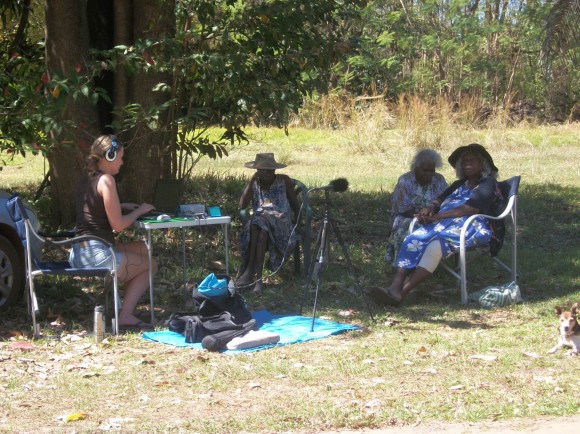MalakMalak and Matngele
The Language is a Map: Spatial Reference in traditional Narratives in MalakMalak and Matngele
When Captain Cook sailed into Botany Bay in 1770 making the first recorded European landfall in Australia, his contact with the indigenous Australians was peaceful, rooted in mutual respect and exchange of goods and language. During the following almost 250 years of European-Australian contact, however, many Aboriginals were systematically oppressed, relocated and sometimes even killed. As a result, today merely 90 of the formerly 250 Australian languages remain, and only 20 are thought to ‘survive’ (Walsh 1991).
In this context, the documentation of Australian languages is situated within a global endeavor to create thorough accessible audio-visual documentation and description of endangered languages. It aims to capture the linguistic features of each language, opening a window into the capabilities of the human mind, as well as their embedding into unique cultural, geographic, and social settings. This project contributes to this goal by thoroughly documenting two neighboring related languages, Matngele and MalakMalak, spoken in remote northern Australia, with a study of their linguistic, literary, and cultural knowledge. All data is archived with ELAR.
Dreamtime narratives are the creation stories of indigenous Australians. They are deeply rooted in landscape and environmental features and create zigzagging ‘invisible’ pathways all over the continent. Each section is assigned an ‘owner’ who is responsible for re-telling the story in order to keep the connection between the land, people, and animals strong. Many stories are told where language and tribal boundaries meet. The two tribes of MalakMalak and Matngele have been in close cultural and linguistic contact for a long time. As such studying the unique dreamtime storytelling techniques in this setting offers exceptional insight into language and literary contact in a highly diverse multilingual and multicultural setting.
The structure of dreamtime narratives in MalakMalak and Matngele opens a window into cultural and grammatical structure. Both languages are of the ‘free’-word order type and with optional ergative/absolutive case-marking syntactic structure is governed by prosody, information structure, and discourse environment. Similarly, ordering within the complex predicates is not fixed and also potentially determined by information structure. There are also a small number of optional noun classifiers whose usage is subject to discourse constraints. Finally, in the same way as the dreamtime stories are part of the land, landscape features are inherent elements of the grammar as expressed in substantial uses of deictic and spatial determiners, coverbs, and suffixes. The very structure of the narratives is determined by spatial ordering and the use of motion descriptions at episode boundaries. Therefore, the structurally rich dreamtime narratives are an excellent discourse environment to investigate these grammatical phenomena.
By involving, speakers, local schools, and adults no longer actively speaking the languages, the proposed project may be able to encourage revitalization processes of both languages.
References
Walsh, Michael. 1991. “Overview of Indigenous languages of Australia.” In Language in Australia, edited by Suzanne Romaine, 27-48. Cambridge: Cambridge University Press.
The Daly River Region: home to MalakMalak and Matngele

